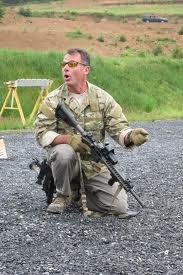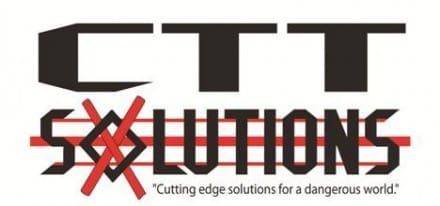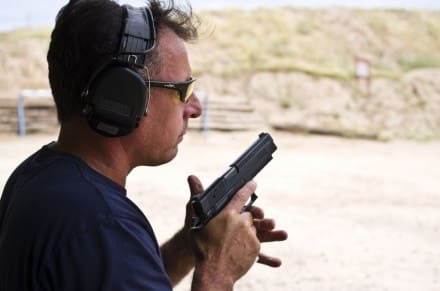Frequently I will use a student’s gun to make a point about the common principles of weapons handling , marksmanship or both. I emphasize the same methodology whether you use an M&P, CZ, HK, Glock or 1911. The same general principle apply regardless of where the magazine release and slide stop are located and what shape they are. You may favor one gun or another but you should be able to shoot any quality pistol accurately if you truly understand the fundamentals of marksmanship. It’s all sights and trigger. I learned at my last unit in the Army that if the bullets aren’t going where you want, in your head you should be saying “sights, trigger, sights, trigger…”
·Sights-properly aligned sights held at the specific point you want to deliver fire
·Trigger- smooth, steady, even pressure exerted straight to the rear without disturbing the lay of the sights.
·Repeat as necessary!
As far as I am concerned there is no such thing as “advanced pistol marksmanship”, only “pistol marksmanship done at an advanced level of skill”. There is no secret mojo that you only learn when the “sensei” says “you are ready to be enlightened.”
That’s pretty much as advanced as marksmanship gets with a pistol. How precisely, rapidly and consistently you do it correlates to how advanced your shooting is.
-Mike Pannone
 Mike Pannone retired from the Army’s premier assault force (1st SFOD-D) after an explosive breaching injury. A year after his retirement America was attacked on 9/11 and he returned to help serve his country as the head marksmanship instructor at the Federal Air Marshals training course and then moved to help stand up the FAMS Seattle field office. In 2003 he left the FAMS to serve as a PSD detail member and then a detail leader for the State Department during 2003 and 2004 in Baghdad and Tikrit.
Mike Pannone retired from the Army’s premier assault force (1st SFOD-D) after an explosive breaching injury. A year after his retirement America was attacked on 9/11 and he returned to help serve his country as the head marksmanship instructor at the Federal Air Marshals training course and then moved to help stand up the FAMS Seattle field office. In 2003 he left the FAMS to serve as a PSD detail member and then a detail leader for the State Department during 2003 and 2004 in Baghdad and Tikrit.
In 2005 he served as a ground combat advisor of the Joint Counter IED Task Force and participated on combat operations with various units in Al Anbar province. Upon returning he gave IED awareness briefings to departing units and helped stand up a pre-Iraq surge rifle course with the Asymmetric Warfare Group as a lead instructor. With that experience as well as a career of special operations service in Marine Reconnaissance, Army Special Forces and JSOC to draw from he moved to the private sector teaching planning, leadership, marksmanship and tactics as well as authoring and co-authoring several books such as The M4 Handbook, AK Handbook and Tactical Pistol shooting. Mike also consults for several major rifle and accessory manufacturers to help them field the best possible equipment to the warfighter, law enforcement officer and upstanding civilian end user. He is considered a subject matter expert on the AR based Stoner platform in all its derivatives.
Gunfighter Moment is a weekly feature brought to you by Alias Training & Security Services. Each week Alias brings us a different Trainer and in turn they offer some words of wisdom.


















































































































